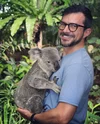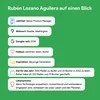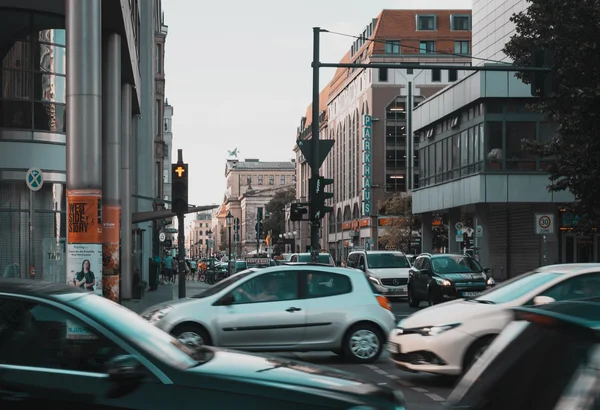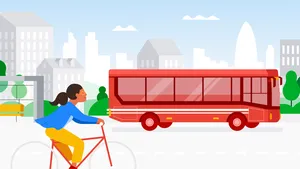Wie das „grüne Blatt“ auf Google Maps kam

This article is also available in English. You can find it below the German version. Diesen Artikel gibt es auch auf Englisch. Ihr findet die englische Version weiter unten.
Wenn man Rubén als „vielseitig“ bezeichnen würde, wäre das eine echte Untertreibung. Der gebürtige Mexikaner studierte Elektrotechnik in seiner Heimat Monterrey, machte einen MBA am Massachusetts Institute of Technology (MIT), ist passionierter Läufer, Leser, LGBTQI+ Aktivist, Maler – und ganz „nebenbei“ arbeitet er bei Google gerade an der Einführung einer der wichtigsten Produktinnovationen im Bereich Klimaschutz: kraftstoffsparende Routen mit Google Maps.
Rubén wuchs in Mexiko auf und erlebte dort schon in jungen Jahren die Auswirkungen des menschengemachten Klimawandels, als seine Heimatstadt mehrmals von Hurrikanen und Dürren betroffen war. Als er nach Seattle zog und die Outdoor-Kultur des pazifischen Nordwestens erlebte, entwickelte er eine tiefe Leidenschaft für die Natur. Er liebt Tiere, wie den Koala oder das ungewöhnliche Schnabeltier. Besonders dessen Fähigkeit, auch in dunklem Wasser mit Hilfe seiner Elektrorezeptoren Beute aufzuspüren, fasziniert ihn. Eine solche Anpassung an die natürlichen Gegebenheiten hält Rubén auch für den Menschen angesichts der Klimakrise für notwendig. Wie groß diese Herausforderung ist, sei ihm während seines Studiums von „System Dynamics“ am MIT im Jahr 2012 bewusst geworden: „Es reicht nicht, dass wir nur ein bisschen unser Verhalten ändern“, glaubt Rubén. „Wir müssen das gesamte System verändern.“

Sein berufliches Ziel stand von da an fest: Er wollte in einem großen Unternehmen an der Nachhaltigkeitsstrategie arbeiten. Und das hat aus heutiger Sicht ziemlich gut geklappt. Nach ersten Stationen bei Amazon und Microsoft arbeitet er seit vier Jahren als Senior Product Manager für Google Maps in Seattle. In den vergangenen Jahren entwickelte er mit seinem Kollegen Vishal Dutta die ersten Ideen, wie man bei der Routenfindung auf Google Maps die verursachten CO2-Emissionen als zusätzlichen Entscheidungsfaktor – neben Schnelligkeit – integrieren könnte. „Nachdem unser CEO Sundar Pichai im September 2020 Googles großen Klimaschutzplan vorgestellt hatte, wurde unser Projekt plötzlich sehr schnell sehr interessant“, berichtet Rubén lachend.

„Indem die Nutzer:innen sich künftig nicht nur für die schnellste, sondern auch für eine kraftstoffsparende Route entscheiden können, könnten die CO2-Emissionen im Straßenverkehr signifikant sinken“, sagt Rubén. Und er sieht einen weiteren Vorteil. „Wenn die Leute das Konzept von CO2-Emissionen besser verstehen, könnte sich auch ihre Einstellung und damit auch ihr Verhalten ändern.” Das sei ähnlich wie bei den Kalorien und dem Essen. Die schönsten Momente sind für Rubén daher auch die, wenn Menschen sein Produkt wirklich nutzen. „Ach, du bist der, der das ‚grüne Blatt‘ auf Google Maps gebracht hat?“, werde er manchmal in den USA gefragt, wo es das Feature „kraftstoffsparende Routen“ bereits seit einem Jahr gibt. Und wenn ihm danach noch jemand sagt, dass sie das Tool jeden Tag nutzen, dann sei das einfach großartig.

Für die Weiterentwicklung von Google Maps hat Rubén natürlich jede Menge Ideen. Insbesondere will er weg vom individuellen Ansatz der Mobilität, der heute noch immer die Norm ist. „Wir müssen zu einem ganzheitlichen System kommen, bei dem auch die gesellschaftlichen Kosten des Autofahrens berücksichtigt werden“, fordert Rubén. „Wie wäre es, wenn wir die Nutzer:innen nicht mehr als Individuen, sondern als Mitglieder der Gemeinschaft betrachten?“, fragt er. Auf diese Weise würde die umweltfreundlichste Route automatisch immer die beste Option.

Rubén hat noch viel vor, um Verkehr mit Klimaschutz in Einklang zu bringen. In seiner Freizeit geht er am liebsten laufen, entweder in der Stadt oder in der Natur. Für ihn ist das die beste Art, die Welt zu erkunden, die Schönheit des pazifischen Nordwestens, die Evergreens, die unzähligen Seen und die Berge zu entdecken. Wenn es um erholsame Ferien geht, ist eine Hütte in den Bergen eines seiner liebsten Ziele. Einer dieser Orte in der Nähe ist der Mount-Rainier-Nationalpark südöstlich von Seattle. Dort auf den fast 5.000 Meter hohen Gipfeln gibt es nur ein Fortbewegungsmittel: die eigenen Füße. Für Rubén nach wie vor die beste Art, sich fortzubewegen – für sich selbst, aber auch für das Klima.

To call Rubén a "multi-talent" would be a real understatement. Born in Mexico, he studied electrical engineering in his home town of Monterrey, did an MBA at the Massachusetts Institute of Technology (MIT), is a passionate runner, reader, LGBTQI+ activist, painter - and "on the side" he is working on one of the most important product innovations in the field of climate protection for Google: eco-friendly routes on Google Maps.
He grew up in Mexico and at a very young age he became conscious about the impact of human activity on the environment, as his hometown experienced multiple climate extremes like hurricanes and water droughts. When he moved to Seattle and embraced the outdoorsy culture of the Pacific Northwest he further developed his passion for nature. He loves animals like the koala or the unusual platypus. He is particularly fascinated by its ability to track down prey even in dark water with the help of its electroreceptors. Rubén believes that such an adaptation to natural conditions is also necessary for humans in view of the climate crisis. During his studies of System Dynamics at MIT in 2012, he realized how big this challenge is: "It's not enough that we just change our behavior a bit," believes Rubén. "We have to change the entire system."
From then on, his professional goal was clear: he wanted to work on the sustainability strategy of a large company. And from today's perspective, that worked out pretty well. After initial positions at Amazon and Microsoft, he has been working as a Senior Product Manager on the Google Maps team in Seattle for four years. Over the past couple of years, he and his colleague Vishal Dutta developed the idea to integrate the CO2 emissions caused when finding a route on Google Maps as an additional decision factor - in addition to speed.
"By allowing users to choose not only the fastest but also the most fuel-efficient route in the future, CO2 emissions from road traffic could drop significantly," says Rubén. And he sees another benefit. "As people better understand the concept of carbon emissions, their attitudes and therefore their behavior may change." For Rubén, the best moments are when people actually use his product. "Oh, you're the one who put the 'green leaf' on Google Maps?" he is sometimes asked in the US, where the eco-friendly routing feature has been around for a year. And if someone tells him afterwards that they use the tool every day, then that's just great.
Of course, Rubén has a lot of ideas on how transportation can evolve. In particular, he wants to move away from the individual approach to mobility, which is still the norm today. "We have to come to a holistic system that also takes into account the social costs of driving, including externalities," Rubén demands.
Rubén still has a lot planned to reconcile transport with climate protection. In his free time he goes running, either in the city or in nature. For him, that is the best way to explore the world, to discover the natural beauty of the Pacific Northwest, the evergreens, the countless lakes and the mountains. When it comes to relaxing vacations, going away to a cabin in the mountains is one of his top picks. One of his favorite nearby (or "local") spots is Mount Rainier National Park, located southeast of Seattle. On Mount Rainier's almost 5,000 meter high peaks, there is only one means of transport: your own feet. For Rubén it's still the best way to get around - for himself, and also for the climate.





